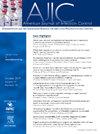经常用酒精消毒不会对医护人员的手部微生物群产生不利影响。
IF 3.8
3区 医学
Q2 INFECTIOUS DISEASES
引用次数: 0
摘要
背景:乙醇擦手液(EBHR)对预防医护相关感染的重要性毋庸置疑。然而,关于乙醇擦手液对皮肤微生物组的影响却缺乏有意义的数据:方法:研究对象包括新生儿重症监护室的四名护士。休假 14 天后,在第一次擦手之前和下班时采集样本,并在第 1、7 和 28 天继续采集样本。为了分析手部微生物群,使用手套汁液技术收集了微生物细胞。通过对 16S 和 18S rRNA 基因标记进行扩增子测序,绘制了原核和真核生物群落图谱:结果:平均每个 8 小时工作班进行 108 次手消毒。微生物群落以人类皮肤上的典型类群为主。此外,还可以观察到明显的护士特异性(即个体)微生物群特征。就原核生物群而言,每天接触会导致不同护士的日终微生物组更为相似。相比之下,使用 28 天的纵向效应则显示出真核生物群落的更大相似性:结论:频繁使用 EBHR 不会对人体手部微生物组的组成产生不利影响。因此,日常手部防腐作为最重要的感染控制程序仍具有重要意义。本文章由计算机程序翻译,如有差异,请以英文原文为准。

No detrimental effect on the hand microbiome of health care staff by frequent alcohol-based antisepsis
Background
The importance of ethanol-based hand rubs (EBHRs) to prevent health care-associated infections is undisputed. However, there is a lack of meaningful data regarding the influence of EBHRs on skin microbiome.
Methods
Four nurses in a neonatal intensive care unit were included. After a leave of 14 days, samples were taken before the first hand rubbing action and at the end of shift, with continued sampling on days 1, 7, and 28. To analyze the hand microbiome, microbial cells were collected using the glove-juice technique. Pro- and eukaryotic community profiles were created using amplicon sequencing of 16S and 18S ribosomal RNA (rRNA) gene markers.
Results
On average, hand antisepsis was performed 108 times per 8-hour work shift. Microbial communities were dominated by typical taxa found on human skin. In addition, a clear nurse-specific (ie, individual) microbiome signature could be observed. For Prokaryota, daily exposure led to the end-of-the-day microbiomes being more similar to each other across nurses. In contrast, longitudinal effect of 28-day application revealed more similarity of the Eukaryotic community.
Conclusions
Frequent occupational use of EBHR did not adversely affect the composition of the human hand microbiome. Thus, daily hand antisepsis retains its significance as the most important procedure for infection control.
求助全文
通过发布文献求助,成功后即可免费获取论文全文。
去求助
来源期刊
CiteScore
7.40
自引率
4.10%
发文量
479
审稿时长
24 days
期刊介绍:
AJIC covers key topics and issues in infection control and epidemiology. Infection control professionals, including physicians, nurses, and epidemiologists, rely on AJIC for peer-reviewed articles covering clinical topics as well as original research. As the official publication of the Association for Professionals in Infection Control and Epidemiology (APIC)

 求助内容:
求助内容: 应助结果提醒方式:
应助结果提醒方式:


